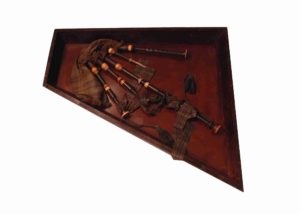Major-General David Stewart of Garth
Just before heading up the stairs to Gallery 4 visitors will see the painting of someone who, on first glance, might not look like a
Home » Blog » News and Events » Paul Cummins – Poppies: Weeping Window at The Black Watch Castle and Museum


Flowers have long been a symbol of remembrance and hope around the world. My artwork Blood Swept Lands and Seas of Red reiterated this for all visitors to experience for themselves. Unexpectedly for all of us involved, the installation touched the hearts of people the world over and visitors travelled across the globe to plant poppies and join in remembrance. Ironically though, this had been my overall aim, to create solidarity across the globe, with people remembering those they lost so we could survive, create peace and develop a brighter future.
Each time a new location to house the sculptures is announced it enhances the overall theme of the original installation, remembrance. The locations chosen each have their links to history, The Great War and the local community remembering their losses, whether that be recent or in the past.
I am incredibly proud to see Weeping Window make its first appearance in mainland Scotland, at The Black Watch Castle and Museum in Perth. The Black Watch, Scotland’s premier Highland regiment, have fought in multiple wars throughout the ages, from its beginnings in 1881, throughout The Great War and recently in Iraq and Afghanistan. The Black Watch Museum tells the story of these soldiers who have given their lives to protect their homeland.
Throughout the First World War, the regiment was in action throughout France, Palestine and Mesopotamia, modernly known as the borders between Iraq, Syria and Kuwait. Their constant appearance throughout the war and the regiment rarely outside of the heart of the action, meant that there was loss throughout the years. The 1918 ‘advance to victory’ saw losses within the regiment of nearly 9,000, with 20,000 wounded or injured. The losses, however, helped to deepen the regimental bond between the hearts of the people in Dundee, Angus, Perthshire and Fife.
Bringing people together in remembrance, understanding and hope for the future, to foster change is what the original installation was all about, and The Black Watch helped to inspire similar change within the Scottish regiment, as well as the community surrounding them.
Weeping Window will be unveiled to all from the 30th June until the 25th September 2016, and I hope that visitors will be impressed by the poppies, but also understand the depth behind their meaning. With the backdrop of The Black Watch Museum and Castle, it seems fitting that visitors will come here to reflect on how war has affected lives.
The other element from Blood Swept Lands and Seas of Red, Wave, is currently on display at Lincoln Castle until the 4th of September. These sculptures will continue to travel the country as part of 14-18 NOW. The 14-18 NOW programme aims to cement a nationwide dialog of the First World Wars legacy towards new audiences. The 14-18 NOW programme was created to celebrate the anniversary of a century since the First World War.
I hope that all those who visit The Black Watch Castle and Museum whilst Weeping Window is in situ will enjoy the display and understand what the pieces have been created to remember. Please enjoy the display and take away from it what you will – it’s been made for your interpretation, reflection and understanding.
Paul Cummins MBE (www.paulcummins.com)
Just before heading up the stairs to Gallery 4 visitors will see the painting of someone who, on first glance, might not look like a

Rosie Waine is the William Grant Foundation Research Fellow at the National Museum of Scotland. Here she writes how the Black Watch Museum & Castle
The Black Watch Museum archive holds a considerable quantity of primary source material relating to the Battle of Loos, 24th September 1915. This event has
Subscribe to Our Newsletter
© The Black Watch Castle and Museum
The Black Watch Regimental Trust is a charitable company registered in Scotland | Charity No: SC005848

1 thought on “Paul Cummins – Poppies: Weeping Window at The Black Watch Castle and Museum”
The Black Watch started its history a bit before 1881! Perhaps a correction to read 1739….?